Trees Birds Mammals Fish Amphibians Reptiles
Wild Algarve
Bookshop
Serratella ignita Poda - Blue-winged Olive
Phylum: Arthropoda - Class: Insecta - Order: Ephemeroptera - Family: Ephemerellidae
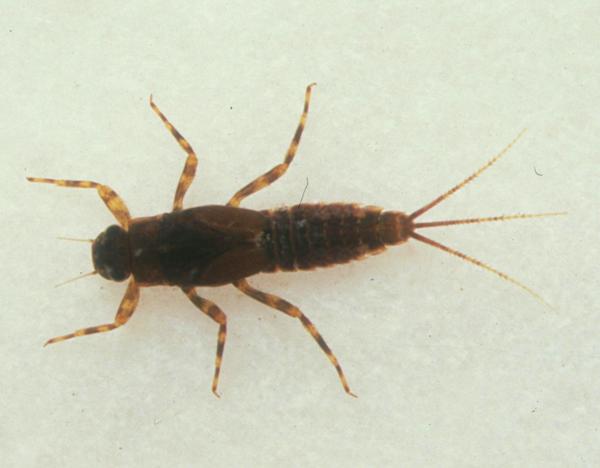
A nymph of the Blue-winged Olive, Serratella ignita
Synonym: Ephemerella ignita
For at least 150 years those anglers who refer to up-winged flies by their scientific names used Ephemerella ignita for the Blue-winged olive, and many still do even though taxonomists have moved this fly out of the genus Ephemerella and into Serratella. In Britain it is the only representative of its genus, members of which are distinguished by paired tubercles on the dorsum of the abdomen. In the USA the Little Sooty Olive, Serratella serrata, is reported to produce good hatches on some eastern rivers.
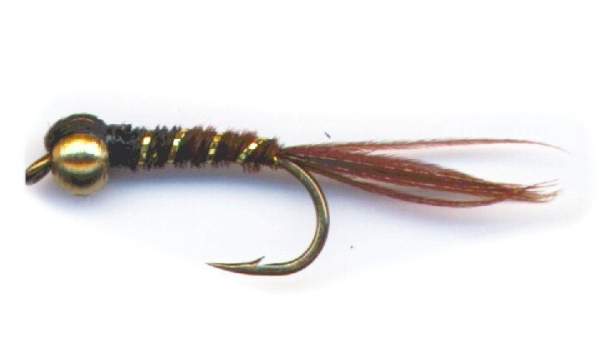
Pheasant-tail Nymph
Blue-winged Olive Nymph
The Blue-winged Olive (often abbreviated to BWO or B-WO) nymphs are moss creepers and although they can swim when necessary they spend most of their formative months crawling within dens mosses or resting
under stones where trout cannot easily find them.
A size 18 Pheasant-tail Nymph moved slowly across the riverbed is an effective imitation, but unless tied on a keel hook or with a weed guard this is a particularly frustrating style of fishing because the hook soon catches either on a stone or more often in mosses, algae or weeds.
Although mainly a fly of fast-flowing rivers and streams, the BWO does also occur on some large wind-swept lakes where there is plenty of water movement around the stony shores. When ready to hatch into duns, BWO nymphs swim up to the surface in open water, and at this stage trout can feed on them in either the nymph, emerger or dun stage.
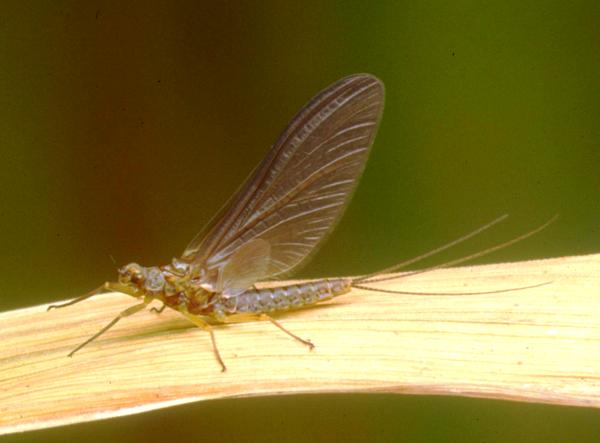
Dun of the Blue-winged Olive, Serratella ignita (female)
Dun or subimago
The Blue-winged Olive is one of those up-winged flies that retain the central tail when they transpose from nymph to dun. (Other common members of the order Ephemeroptera that have three tails in their winged-insect states include the Mayfly, Ephemera species; Angler's Curse or Broadwings, Caenis species; and the group of swarthy little flies in the genera Leptophlebia, Paraleptophlebia and Habroleptophlebia most of which are uncommon to rare in Britain and Ireland and therefore of limited interest to flyfishers.
The Yellow Evening Dun, Ephemerella notata, is a very close relative of the Blue-winged Olive, and not surprisingly it too has three tails at the dun and spinner stages.)
Male and female BWO duns look quite similar, with blue-grey wings and grey tails. Males are distinguished by their large chestnut-coloured eyes and brown-olive bodies, whereas females have much smaller eyes and olive-green bodies.
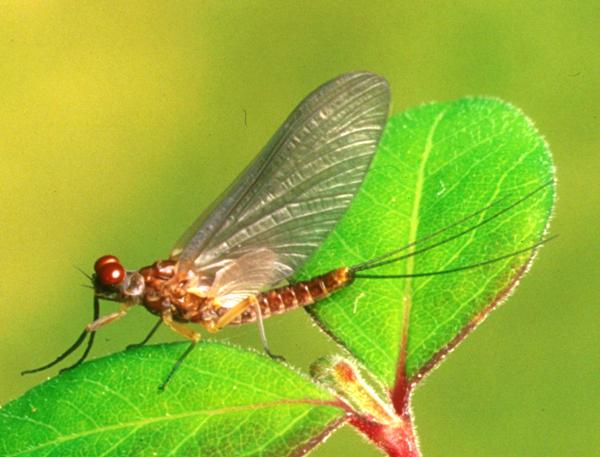
Dun of the Blue-winged Olive, Serratella ignita (male)
The duns hatch from mid morning until late afternoon, and are most abundant in June, July and early August, although you can generally see a few Blue-winged Olives in all but the worst of weather between late April and mid to late September.
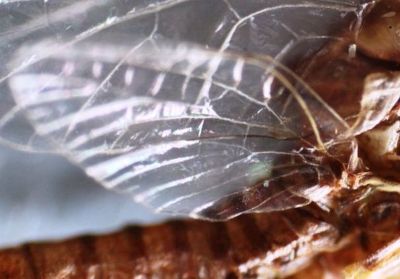
The picture above shows the large oval hindwing of a female spinner.
Matching the BWO dun hatch
When Blue-winged Olive duns are hatching in profusion, trout can become preoccupied with these three-tailed little olives to the point where other, sometimes much larger insects are ignored. Matching the hatch is then a matter of choosing an olive representation of roughly the right size.
In fast water any general representation olive should be acceptable, and that age-old favourite Greenwell's Glory is as good as anything. Size 16 is about right to match the BWO dun, but in very turbulent water you can safely go for an easier-to-see (for trout and flyfishers) size 14.
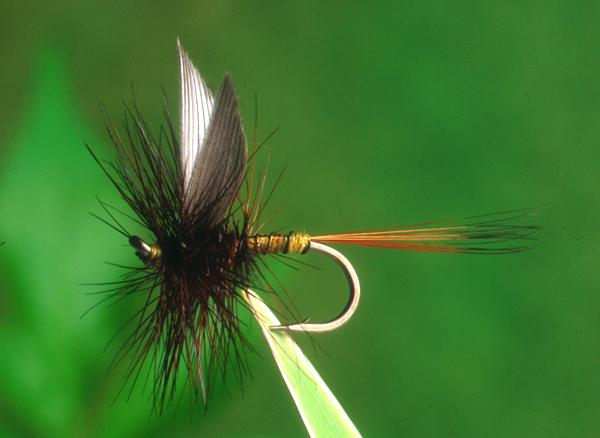
Greenwell's Glory, an adequate match for the BWO dun in fast water
Fishing tip
If you like to tie your own flies to match the natural flies appearing through the season, here is a potential pitfall worth being aware of:
The BWO duns that trout are most likely to be able to see and feed on are those that have just left their nymphal shucks and are sitting on the surface of the water while their wings harden and dry. At this stage the bodies are very much paler - light olive-green is a good description - than they will be a couple of hours later. So, if you hunt for specimens in the bushes beside the water its worth remembering that their bodies will be quite a lot darker than those that trout are used to seeing. Of course, that's not to say that a subtle change in body colour is likely to make much difference to your fishing results, but on a cloudy day or when fishing beneath trees so that trout see more than a silhouette of your fly, it's one more excuse for a cautious old trout playing safe and rejecting your offering.
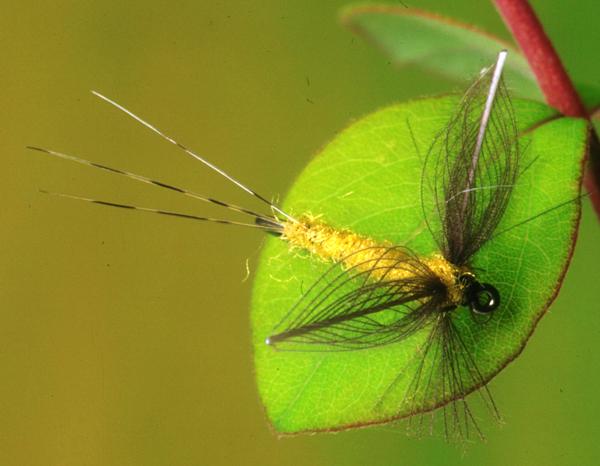
CDC Dun tied by Andrew Ryan of Clonanav Flyfishing Centre, Ireland
On the gentle glides of clear chalkstreams or lowland limestone rivers, fish get plenty of time to decide whether a morsel floating on the surface is a genuine meal or a false alarm. Rising up to thistle down is for tiddlers; wise old trout use their eyes to conserve energy. This is the kind of situation that calls for a closer imitation of the natural insect.
For more accurately matching the BWO dun hatch one of my favourites is a CDC Dun (CDC stands for cul-de-canard, and the wings of this fly are tied with feathers from the oil gland at the part of a duck that rely does have to be watertight; they are therefore very good at staying afloat.)
In Matching the Hatch I give tying details for this super fly, but the sample pictured here shows how the CDC wings should be formed. Cul-de-canard is also used to represent the legs of the insect. The tails are three Coq-de-Leon fibres.
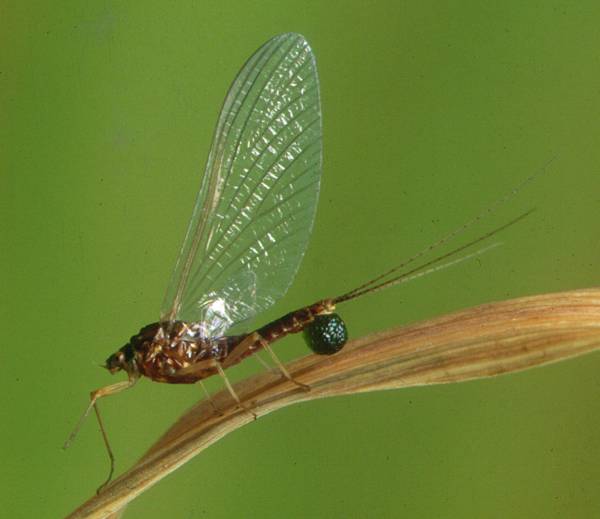
Female Blue-winged Olive spinner with egg ball
Spinner or imago
The Sherry Spinner is the common name that anglers have given to the female spinner of the Blue-winged Olive. The orange-brown body colour is rather like a medium sherry.
A female BWO spinner is seen
here with her green ball of eggs. This is a very important fly on the rivers
of Britain, and particularly dense hatches occur on some chalkstreams and spate rivers including the Test in southern England and the Teifi in West Wales.
Fishing tip
On spate rivers, Female Blue-winged Olive spinners tend to congregate above the rapid
waters between pools. There they swarm just before egg laying, and trout
take up station either on the lip of the pool or at the head of the next
pool downstream. Each spinner carries its ball of eggs attached beneath its abdomen, and it as it dips and touches the water the eggs drift free and sink to the bed of the river.
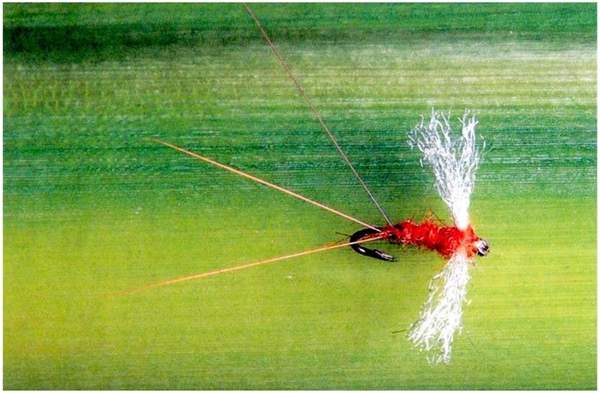
CDC-Winged Sherry Spinner
A dry Sherry Spinner fished on the riffles where BWO spinners are laying their eggs often tempts
some very fine trout in the orange glow of a fine summer evening. Again I make use of CDC, but for matching the fall of spent spinners it is much better if the wings of your dry fly are tied in the spent position.
No body colour reflects orange light better than an orange one, and so all of my artificial Sherry Spinners are tied with brilliant orange body material. The trout can see these flies much more easily than they could if I put more brown into the body dubbing. And even more importantly, I can see my Sherry Spinner at reasonable distance a lot later into the evening, which is when some of the best trout rise.
Excited at the prospect of flyfishing? So are we, and we're pretty sure you would find the Winding River Mystery trilogy of action-packed thrillers gripping reading too. Dead Drift, Dead Cert, and Dead End are Pat O'Reilly's latest river-and-flyfishing based novels, and now they are available in ebook format. Full details on our website here...
Buy each volume in ebook format for only £2.47 on Amazon... Paperbacks also available on Amazon at £5.45 each. All proceeds go towards keeping the First Nature website online.
Please Help Us: If you have found this information interesting and useful, please consider helping to keep First Nature online by making a small donation towards the web hosting and internet costs.
Any donations over and above the essential running costs will help support the conservation work of Plantlife, the Rivers Trust and charitable botanic gardens - as do author royalties and publisher proceeds from books by Pat and Sue.